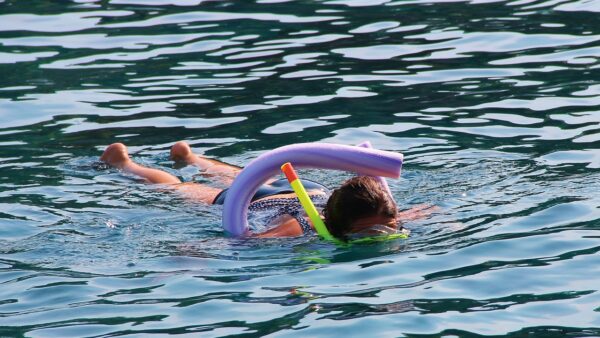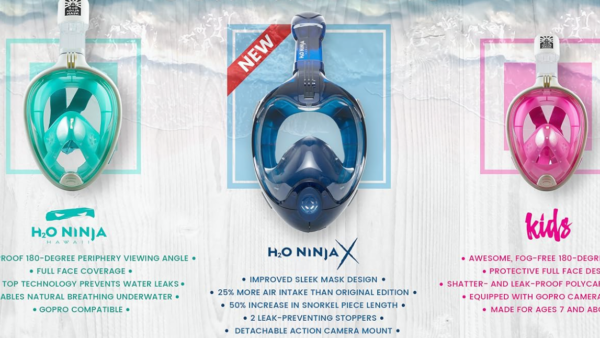In this article, you’re going to learn all you need to know about snorkeling and snorkeling equipment.
Snorkeling is a very popular pastime activity for people of all ages. If you’re looking for a new hobby to fill your time with, now is as good a time as any to pick up snorkeling. Needless to say, you’ll need to know a couple of things about this activity before you can jump right in. But don’t worry because that’s exactly what we’re here for. In this article, you’re going to learn all you need to know about snorkeling and snorkeling equipment.
How Does Snorkeling Work?

It’s worth keeping in mind that snorkeling and scuba diving are not the same thing. Scuba divers can go a lot deeper underwater and can remain there for longer when compared to snorkelers. However, the advantage of snorkeling is that you don’t need a whole lot of equipment to pull it off. Snorkeling replaces the full body suit and huge air tank you see on the backs of scuba divers with a couple of lighter pieces of equipment.
Getting a good wetsuit is still recommended in certain circumstances but it all depends on what kind of waters you want to dive it. For example, you’ll definitely need a suit if you’re snorkeling in cold waters. On the other hand, if you’re teaching your kid how to snorkel in your backyard pool you don’t really need to worry about a wetsuit.
How Does Snorkeling Equipment Work?
Now that you know a little bit about what to expect you’re probably wondering about the type of equipment you’ll need. At the very least you’ll need a good mask and snorkel combo, as well as a wetsuit and some fins depending on where you’re diving. There’s no shortage of companies that sell all of these items but picking the right gear for your particular needs is key.
So how does snorkeling underwater work? Well, since there’s no oxygen tank in snorkeling you’ll need to rely entirely on your face gear for breathing. More precisely, the snorkel itself. You’ll want to make sure that the snorkel is never entirely submerged, which is why it is recommended that you don’t dive more than a few feet underwater. Snorkeling masks tend to come equipped with safety features to ensure that you can breathe normally while submerged, however, it’s up to you to make sure that you’re using all the equipment properly. More on this in the next section.
The Individual Components of Your Snorkeling Gear
In this section, we’re going to break down what your gear should consist of, as well as give you a bit of advice in regards to what sort of items you may want to pick up. As mentioned, there’s a lot of variety out there but make sure you do the necessary research before buying your snorkeling gear because there are a few key factors you should keep in mind.
The Mask
Snorkeling masks can be found all over the place, including many supermarkets. Needless to say, you’ll want to stay away from those and instead try to find a mask that was specifically designed for snorkeling. By this, I mean that the mask should be highly resistant and have the ability to seal properly around your face. Visual appearance and price are certainly things that you should consider but the main thing you should be looking for is quality.
Good snorkeling masks are made from shatterproof materials and should be able to easily withstand underwater pressure. At least, the pressure you’re going to experience in shallow water. You also want to make sure that you have a good field of vision underwater so the viewing area should be suitably large. Finally, and most importantly, the mask should fit perfectly on your face.
It goes without saying that you’re going to run into a lot of trouble if water starts sipping into the mask while you’re diving. In order to make sure that doesn’t happen, you’ll want to test out the mask before you go snorkeling. Put the mask on and see if it fits properly on your face without causing any sort of discomfort. If it feels like air is coming in through the sides, the mask is probably too big for your face. On the other hand, if you start feeling pressure after wearing the mask for a few minutes that means it’s probably too small. In short, it has to fit perfectly.
The Snorkel
While you are able to find full face masks that don’t feature a separate snorkel, we are going to talk a bit about the snorkel in this article just in case you decide to go for a more traditional mask. The snorkel is a very simple piece of equipment that allows you to breathe underwater while submerged. So how does the snorkel work? Well, the basic premise is pretty straightforward. The snorkel consists of a tube that features a floating component and one-way filters that prevent water from getting it.
When it comes to choosing the right snorkel for you it’s important to go for one that isn’t too long. Longer snorkels are harder to breathe through and you definitely don’t want that. On the other hand, a very short snorkel will not allow you do dive very deep, which isn’t exactly ideal either. In other words, look for a medium length snorkel. Preferably you’ll also want to make sure that the snorkel is attached to the mask strap for extra safety.
The Wetsuit
As mentioned earlier, a wetsuit isn’t strictly mandatory for snorkeling, but it might come in handy regardless. If you’re diving in tropical waters you won’t need a suit, however, it is recommended that you go for something like a rash guard in order to protect your skin from sun exposure. Snorkeling can also be done in cooler waters and in this case, you’ll need a neoprene top. The top can be either sleeveless, full-sleeved or short-sleeved depending on your personal preference.
Having said all that, if you plan on snorkeling in particularly cold waters you’ll definitely need a wetsuit just to be on the safe side. Wetsuits are also made from neoprene and provide much needed thermal insulation along with a few other benefits, including buoyancy. Make sure to take into consideration this factor because it will dictate how deep you can expect to be able to submerge yourself. Again, you’re not meant to dive deeper than a few feet with snorkeling gear so keep that in mind.
The Fins
The last piece of equipment you’re going to need is a pair of fins. Much like all the other items, you’ll have plenty of different models to choose from, as well as a few different variants. The type you should go for depends on the temperature of the water and the depth at which you’re snorkeling. For example, full-heel fins are the ideal choice for warm water while open-heel fins are better for cold waters.
Also worth taking into account is the length of the fins. Longer fins are a great choice if you’re going for the maximum recommended snorkeling depth as they give you more thrust while underwater. But if you’re only interested in some basic snorkeling and plan on sticking close to the surface, you should probably go for a pair of shorter fins. These are much more practical and take up less space so you won’t have any problems finding a place for them in your luggage.
Above all else, you’ll want to make sure that the fins are comfortable. You won’t be able to figure out if that’s really the case just by looking at them so make sure to go out and try a few pairs and see how they fit. This is particularly important for longer snorkeling sessions as the fins will start to feel very uncomfortable in no time if they don’t fit properly.
Final Word
If the question “how does snorkeling underwater work?” was on your mind before, hopefully, that’s not the case anymore. Just like everything else, practice makes perfect when it comes to snorkeling so pick up the right equipment, choose a suitable location, and start practicing. You won’t become a master overnight and it might be somewhat difficult at first but in time you’ll find that this is a very fun and rewarding hobby.
Once you have your snorkeling equipment all sorted out, consider also adding a small knife to your gear just to be on the safe side. This item won’t be necessary in most cases but it all depends on where you’re snorkeling. For example, there’s a risk of entanglement while diving in areas with old fishing nets or sea kelp.
The chances of entanglement are generally very low, but you never know. The wisest thing to do is to avoid these types of waters altogether but if you don’t know the area very well it’s good to have a backup plan, just in case. There are certain situations where a knife can come in handy, but do pick a small one that can be easily attached to your lower leg. Also, make sure you have a holster to go with it in order to avoid getting injured.





